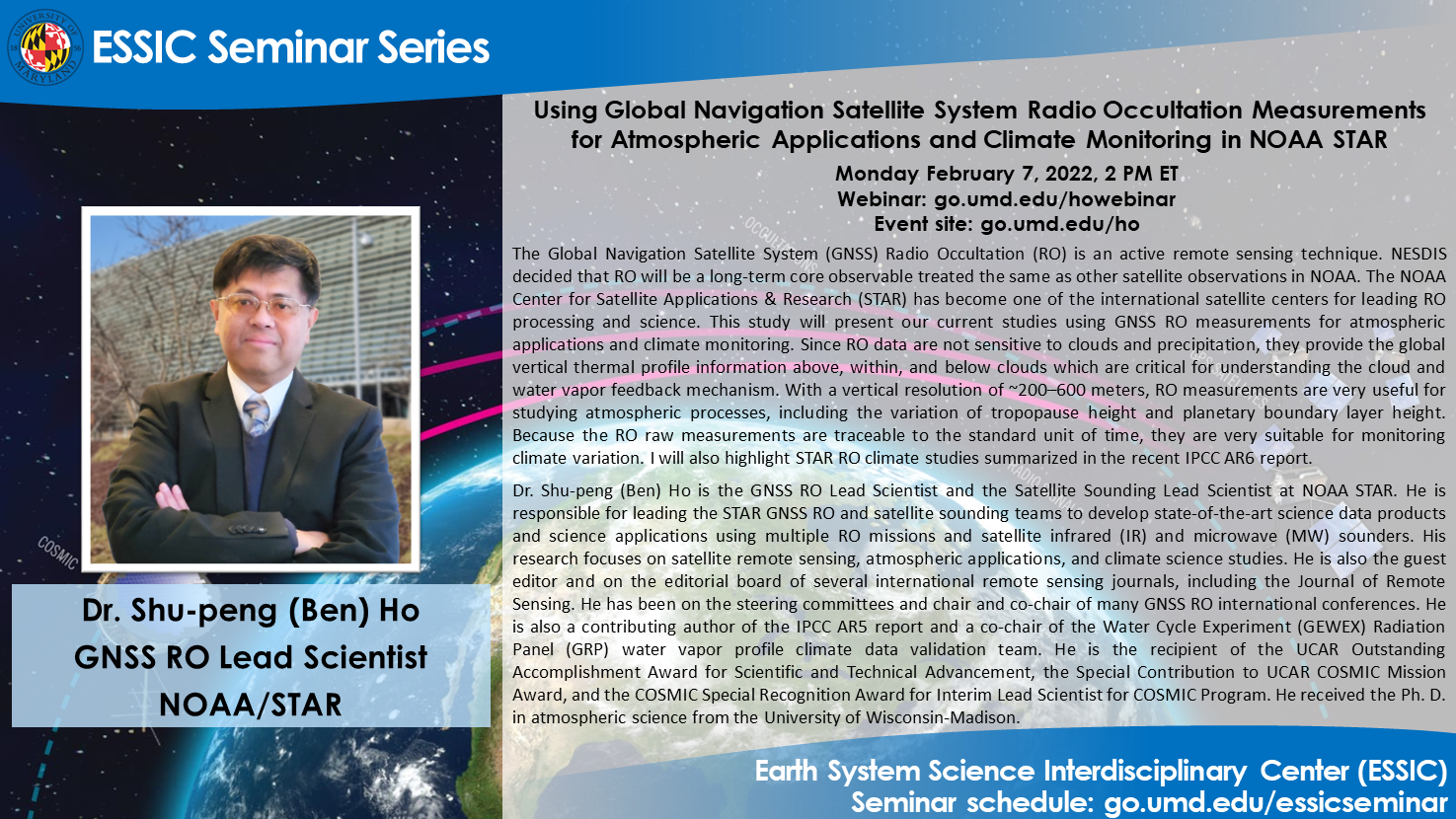
Using Global Navigation Satellite System Radio Occultation Measurements for Atmospheric Applications and Climate Monitoring
This event has passed. View the seminar recording here:

Dr. Shu-peng (Ben) Ho
GNSS RO Lead Scientist
NOAA/STAR
Monday February 7, 2022, 2 PM ET
Abstract:
The Global Navigation Satellite System (GNSS) Radio Occultation (RO) is an active remote sensing technique, which is complementary with the passive microwave (MW) and infrared (IR) sounders and microwave imagers. NESDIS decided that RO will be a long-term core observable treated the same as other satellite observations in NOAA. STAR has become one of the international satellite centers for leading RO processing and science. This study will present our current studies using GNSS RO measurements for atmospheric applications and climate monitoring. I will demonstrate that because RO data are not sensitive to clouds and precipitation, they can provide the global vertical thermal profile information above, within, and below clouds which are critical for understanding the cloud and water vapor feedback mechanism. In addition, I will also demonstrate that with a vertical resolution of ~200–600 meters, RO measurements are very useful for studying atmospheric processes, including the variation of tropopause height and planetary boundary layer height. Because the raw measurements for the RO technique are traceable to the standard unit of time, we can also use RO measurements as the on-orbit references for satellite instrument calibration. I will also highlight STAR RO climate studies summarized in the recent IPCC AR6 report.
Biosketch:
Dr. Shu-peng (Ben) Ho is the Global Navigation Satellite System (GNSS) radio occultation (RO) Lead Scientist and the Satellite Sounding Lead Scientist at NOAA Center for Satellite Applications & Research (STAR). He is responsible for leading the STAR GNSS RO and satellite sounding teams to develop state-of-the-art science data products and science applications using multiple RO missions and satellite infrared (IR) and microwave (MW) sounders. His research focuses on satellite remote sensing, atmospheric applications, and climate science studies. He is also the guest editor and on the editorial board of several international remote sensing journals, including the Journal of Remote Sensing. He has been on the steering committees and chair and co-chair of many GNSS RO international conferences. He is also a contributing author of the IPCC AR5 report and a co-chair of the Water Cycle Experiment (GEWEX) Radiation Panel (GRP) water vapor profile climate data validation team. He is the recipient of the UCAR Outstanding Accomplishment Award for Scientific and Technical Advancement, the Special Contribution to UCAR COSMIC Mission Award, and the COSMIC Special Recognition Award for Interim Lead Scientist for COSMIC Program. He received the Ph. D. in atmospheric science from the University of Wisconsin-Madison.
Webinar:
Webinar: https://go.umd.edu/howebinar
Event site: https://go.umd.edu/ho
Webinar number: 2623 345 6491
Webinar password: essic
To join the audio conference only:
US Toll: +1-415-655-0002
Global call-in numbers
For IT assistance:
Cazzy Medley: cazzy@umd.edu
Resources:
Seminar schedule & archive: https://go.umd.edu/essicseminar
Seminar Google calendar: https://go.umd.edu/essicseminarcalendar
Seminar recordings on Youtube: https://www.youtube.com/user/ESSICUMD

